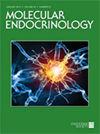Gαz缺乏和GLP-1类似物治疗在实验性糖尿病中维持功能性β细胞质量的协同作用
Q Biochemistry, Genetics and Molecular Biology
引用次数: 25
摘要
1型糖尿病(T1DM)病理生理的一个决定性特征是胰腺β细胞死亡和功能障碍,导致胰岛素分泌不足,无法适当控制血糖水平。促进β细胞复制和存活的治疗,从而逆转β细胞质量的损失,同时也保持β细胞的功能,可能导致真正治愈T1DM。异三聚体Gz蛋白的α-亚基Gαz是腺苷酸环化酶和下游cAMP生成的强直负调节因子。cAMP是为数不多的可同时对胰岛β细胞增殖、存活和功能产生积极影响的信号分子之一。我们研究的目的是确定缺乏g - αz的小鼠在链脲佐菌素治疗后是否可以保护(至少部分地)免受β细胞丢失和功能障碍。我们还旨在确定Gαz是否可能与camp刺激胰高血糖素样肽1受体Ex4 (Ex4)的激活剂协同作用。在没有Ex4处理的情况下,g - α - z缺失的小鼠仍然会发生高血糖,只是延迟了。同样的发现也适用于用Ex4处理的野生型小鼠。经Ex4处理,g - α - z缺失小鼠可避免发生严重的高血糖。胰腺切片的免疫组织学研究、体外细胞凋亡、细胞毒性和存活试验表明,g - αz信号传导对胰腺β细胞复制和死亡有明显影响;g - α - z缺失的胰岛β细胞功能也得到改善。这些数据支持了我们的假设,即在T1DM中,针对刺激和抑制途径的联合治疗在保护、保存和可能再生β细胞质量和功能方面比单独治疗更有效。本文章由计算机程序翻译,如有差异,请以英文原文为准。
Synergy Between Gαz Deficiency and GLP-1 Analog Treatment in Preserving Functional β-Cell Mass in Experimental Diabetes.
A defining characteristic of type 1 diabetes mellitus (T1DM) pathophysiology is pancreatic β-cell death and dysfunction, resulting in insufficient insulin secretion to properly control blood glucose levels. Treatments that promote β-cell replication and survival, thus reversing the loss of β-cell mass, while also preserving β-cell function, could lead to a real cure for T1DM. The α-subunit of the heterotrimeric Gz protein, Gαz, is a tonic negative regulator of adenylate cyclase and downstream cAMP production. cAMP is one of a few identified signaling molecules that can simultaneously have a positive impact on pancreatic islet β-cell proliferation, survival, and function. The purpose of our study was to determine whether mice lacking Gαz might be protected, at least partially, from β-cell loss and dysfunction after streptozotocin treatment. We also aimed to determine whether Gαz might act in concert with an activator of the cAMP-stimulatory glucagon-like peptide 1 receptor, exendin-4 (Ex4). Without Ex4 treatment, Gαz-null mice still developed hyperglycemia, albeit delayed. The same finding held true for wild-type mice treated with Ex4. With Ex4 treatment, Gαz-null mice were protected from developing severe hyperglycemia. Immunohistological studies performed on pancreas sections and in vitro apoptosis, cytotoxicity, and survival assays demonstrated a clear effect of Gαz signaling on pancreatic β-cell replication and death; β-cell function was also improved in Gαz-null islets. These data support our hypothesis that a combination of therapies targeting both stimulatory and inhibitory pathways will be more effective than either alone at protecting, preserving, and possibly regenerating β-cell mass and function in T1DM.
求助全文
通过发布文献求助,成功后即可免费获取论文全文。
去求助
来源期刊

Molecular endocrinology
医学-内分泌学与代谢
CiteScore
3.49
自引率
0.00%
发文量
0
审稿时长
12 months
期刊介绍:
Molecular Endocrinology provides a forum for papers devoted to describing molecular mechanisms by which hormones and related compounds regulate function. It has quickly achieved a reputation as a high visibility journal with very rapid communication of cutting edge science: the average turnaround time is 28 days from manuscript receipt to first decision, and accepted manuscripts are published online within a week through Rapid Electronic Publication. In the 2008 Journal Citation Report, Molecular Endocrinology is ranked 16th out of 93 journals in the Endocrinology and Metabolism category, with an Impact Factor of 5.389.
 求助内容:
求助内容: 应助结果提醒方式:
应助结果提醒方式:


